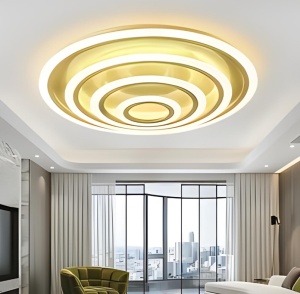
Elegant Chandelier: A Showstopping Statement Piece
Chandeliers Acorohome have a rich and fascinating history that dates back to ancient times. The word “chandelier” is derived from the French word “chandelle,” which means candle. In the medieval period, chandeliers were used as a practical lighting solution in castles and churches, typically made of wood or iron and adorned with candles. As time progressed, chandeliers evolved into more ornate and decorative fixtures, often made of brass, crystal, or glass. During the 18th century, chandeliers became a symbol of wealth and status, adorning the grand palaces and mansions of the aristocracy. The invention of gas lighting in the 19th century further revolutionized chandelier design, allowing for more intricate and elaborate styles.
In the early 20th century, the advent of electricity led to a new era of chandelier design, with innovative materials such as wrought iron, bronze, and even plastic being used to create stunning and diverse chandelier styles. Today, chandeliers continue to be a popular lighting choice for both residential and commercial spaces, with a wide range of designs to suit every taste and decor style. From traditional crystal chandeliers to modern minimalist designs, the evolution of chandeliers has transformed them from purely functional lighting fixtures to fabulous statement pieces that can elevate any room.
Choosing the Right Chandelier for Your Space: Size, Style, and Placement
When selecting a chandelier for your space, there are several important factors to consider to ensure that it complements the room and enhances the overall aesthetic. The first consideration is the size of the chandelier in relation to the room. A general rule of thumb is to measure the length and width of the room in feet and then add those two numbers together to determine the ideal diameter of the chandelier in inches. For example, a room that is 12 feet by 14 feet would require a chandelier with a diameter of 26 inches. It’s also important to consider the height of the ceiling when choosing a chandelier, as a low-hanging fixture can make a room feel cramped, while a high ceiling may require a larger and more substantial chandelier to make an impact.
In addition to size, the style of the chandelier should also be carefully considered to ensure that it complements the existing decor of the room. Traditional crystal chandeliers are timeless and elegant, while modern and minimalist designs can add a contemporary touch to a space. The placement of the chandelier is equally important, as it should be positioned to provide adequate lighting without overwhelming the room. In dining rooms, for example, the chandelier should be centered over the table and hung at a height that allows for comfortable conversation without obstructing the view. By carefully considering size, style, and placement, you can choose the perfect chandelier to enhance your space.
Making a Statement: How an Elegant Chandelier Can Transform a Room
An elegant chandelier has the power to completely transform a room, adding drama, sophistication, and a touch of luxury. Whether it’s a traditional crystal chandelier dripping with sparkling prisms or a sleek and modern design that serves as a striking focal point, the right chandelier can elevate the ambiance of any space. In a dining room, a well-chosen chandelier can create an intimate and inviting atmosphere for entertaining guests, while in a living room or foyer, it can make a bold statement that sets the tone for the entire space.
The impact of a chandelier goes beyond its practical function as a source of light; it also serves as a work of art that enhances the overall design scheme of a room. A carefully selected chandelier can tie together different elements of a room’s decor, whether it’s adding a touch of glamour to a traditional setting or providing a contemporary edge to a modern space. The play of light and shadow created by a chandelier can also add depth and dimension to a room, creating an enchanting ambiance that is both functional and visually captivating. By choosing an elegant chandelier that complements the style and scale of your space, you can make a lasting impression and transform any room into a truly remarkable environment.
Maintenance and Care for Your Showstopping Chandelier
Once you’ve chosen the perfect chandelier for your space, it’s important to maintain and care for it to ensure that it continues to shine as a showstopping centerpiece. Regular cleaning is essential to keep your chandelier looking its best, especially if it’s adorned with crystals or glass elements. Dust can accumulate on these surfaces over time, dulling their sparkle and diminishing their beauty. To clean your chandelier, start by turning off the power and allowing the bulbs to cool before removing any delicate pieces. Use a soft cloth or duster to gently wipe away dust and debris from each individual component, taking care not to apply too much pressure or force.
For more thorough cleaning, you can use a solution of mild dish soap and water to gently wash glass or crystal elements, being sure to dry them thoroughly afterward to prevent water spots. It’s also important to inspect the wiring and electrical components of your chandelier regularly to ensure that everything is in good working order. If you notice any loose or damaged parts, it’s best to consult a professional electrician or lighting specialist for repairs. By taking the time to properly maintain and care for your showstopping chandelier, you can preserve its beauty and functionality for years to come.
Incorporating a Chandelier into Different Design Styles: Traditional, Modern, and Eclectic
Chandeliers are incredibly versatile fixtures that can be incorporated into a wide range of design styles, from traditional and classic to modern and eclectic. In traditional spaces, such as formal dining rooms or grand foyers, crystal chandeliers with ornate details and intricate designs are often used to add an air of elegance and sophistication. These timeless fixtures are characterized by their sparkling crystals and graceful silhouettes, making them an ideal choice for traditional interiors that exude luxury and refinement.
In contrast, modern spaces benefit from sleek and minimalist chandeliers that feature clean lines and contemporary materials such as metal or glass. These designs often prioritize form over ornamentation, creating a striking focal point that complements modern decor without overpowering it. In eclectic interiors that blend different styles and periods, chandeliers offer an opportunity to make a bold statement and add an unexpected twist. Whether it’s a vintage-inspired fixture with an industrial edge or a whimsical design that defies convention, an eclectic chandelier can inject personality and character into any space. By carefully selecting a chandelier that aligns with your design style, you can enhance the overall aesthetic of your space and create a cohesive look that is both visually captivating and harmonious.
DIY Chandelier Installation: Tips and Tricks for a Successful Project

Installing a chandelier can be a rewarding DIY project that adds beauty and functionality to your space, but it’s important to approach the task with care and attention to detail. Before you begin, it’s essential to turn off the power at the circuit breaker to ensure safety during installation. If you’re replacing an existing light fixture with a chandelier, start by removing the old fixture and assessing the electrical box to ensure that it can support the weight of the new chandelier. If necessary, you may need to install a support brace or additional hardware to secure the fixture properly.
When hanging the chandelier, it’s crucial to follow the manufacturer’s instructions for assembly and installation carefully. Use a voltage tester to confirm that the power is off before connecting the wiring, and be sure to secure all connections tightly to prevent any loose or exposed wires. Once the chandelier is in place, double-check that it is level and balanced before turning on the power to test its functionality. By taking your time and following these tips and tricks for DIY chandelier installation, you can ensure a successful project that adds beauty and illumination to your space.
The Future of Chandeliers: Trends and Innovations in Lighting Design
As lighting technology continues to advance, so too do the trends and innovations in chandelier design. One emerging trend is the use of energy-efficient LED lighting in chandeliers, which offers long-lasting illumination with minimal energy consumption. LED chandeliers come in a variety of styles and designs, from sleek and contemporary fixtures to traditional crystal designs that incorporate LED technology for enhanced brilliance.
Another trend in chandelier design is the use of mixed materials and textures to create unique and eye-catching fixtures. Combining metal with wood, glass with fabric, or even unconventional materials such as recycled plastics or sustainable fibers allows for endless possibilities in chandelier design. These innovative combinations add depth and visual interest to chandeliers while also reflecting a growing emphasis on sustainability and eco-friendly design practices.
In terms of form and function, customizable chandeliers are becoming increasingly popular as homeowners seek personalized lighting solutions that cater to their specific needs and preferences. From adjustable arms and interchangeable components to smart lighting capabilities that can be controlled via mobile devices, customizable chandeliers offer versatility and adaptability for modern living spaces.
Overall, the future of chandeliers is bright with exciting possibilities for new materials, technologies, and design concepts that will continue to push the boundaries of lighting innovation. Whether it’s through energy-efficient LED lighting, mixed materials and textures, or customizable features, chandeliers are poised to remain at the forefront of lighting design as timeless yet ever-evolving fixtures that captivate and inspire.


